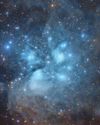Prøve GULL - Gratis
DYSON SPHERE
All About Space
|Issue 109
Could an advanced civilisation harness the power of stars to sustain their energy needs?
-

First proposed by physicist Freeman Dyson in 1960, a Dyson sphere is a hypothetical swarm of satellites that would surround a star in order to harness its energy. Although more commonly known as a Dyson swarm, some people have discussed the possibility that rather than a swarm of satellites, a star could be encased in a solid sphere by a future civilisation – but this is an idea that Dyson himself was keen to stray away from. Indeed, for a planetary system like our own, such a structure would likely require every object in the Solar System other than the Sun to be dismantled and rebuilt into a giant sphere owing to the huge size of the Sun.
Dyson’s initial proposal was suggested as a way that a future civilisation could sate their vast energy needs. As the energy requirements of a civilisation increase, they may require an ever-growing amount of energy, a crisis perhaps solved only by harnessing the power of stars.
This carries further connotations that there could be advanced races elsewhere in the universe that have built such structures. Dyson postulated that these would radiate a large amount of infrared radiation, noticeable even to us here on Earth.
Denne historien er fra Issue 109-utgaven av All About Space.
Abonner på Magzter GOLD for å få tilgang til tusenvis av kuraterte premiumhistorier og over 9000 magasiner og aviser.
Allerede abonnent? Logg på
FLERE HISTORIER FRA All About Space

All About Space UK
MYSTERIES OF THE UNI WHERE ARE ALL THE SPIRAL GALAXIES?
There are far fewer spiral galaxies than elliptical ones in the Supergalactic Plane, and scientists are keen to discover why
7 mins
Issue 161

All About Space UK
ZOMBIE STARS
+10 OTHER TERRIFYING SPACE OBJECTS
8 mins
Issue 161

All About Space UK
HOW TO BEAT LIGHT POLLUTION
Thought it was impossible to observe the wonders of the night sky from towns and cities? Think again. Follow our tips and tricks on successfully observing through sky glow
2 mins
Issue 161

All About Space UK
15 STUNNING STAR CLUSTERS
These beautiful stellar groupings are spattered across the cosmos
8 mins
Issue 161

All About Space UK
Eileen Collins "It was a difficult mission...we were the first to see Mir"
Having served as both the first female pilot and first female commander of NASA's Space Shuttle, Collins boosted the involvement of women in space exploration to a whole new level
9 mins
Issue 161

All About Space UK
MARS LEAKS FASTER WHEN IT'S CLOSER TO THE SUN
The Red Planet has lost enough water to space to form a global ocean hundreds of kilometres deep
2 mins
Issue 161

All About Space UK
FUTURE TECH KANKOH-MARU
This ambitious reusable spacecraft will be capable of taking 50 people to and from orbit
2 mins
Issue 161

All About Space UK
THE FINAL FRONTIER
Beyond the reach of the Sun is a fascinating region of the cosmos that were only just beginning to explore
8 mins
Issue 161

All About Space UK
A long-lost moon could explain Mars' weird shape and extreme terrain
A long-lost moon could explain why Mars is so different from the other rocky planets in the Solar System. Today Mars has two tiny moons.
2 mins
Issue 161

All About Space UK
A sprinkling of cosmic dust may have helped kick-start life on Earth
Cosmic dust may have helped kick-start life on Earth. New findings challenge a widely held assumption that this wasn't a plausible explanation.
3 mins
Issue 161
Translate
Change font size
